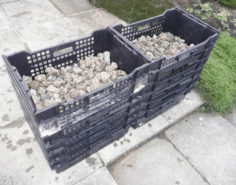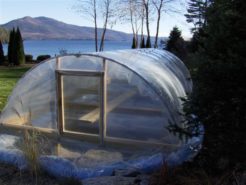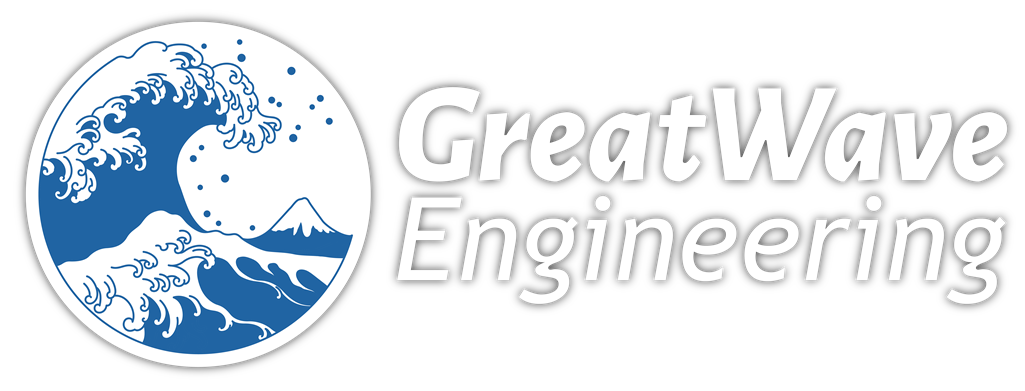On 4/26/14 Michael sent me a couple of questions and I responded.
Question/Comment:
Do gel balls come with a purchase of Biohome products, as seemed to be indicated in the video I just watched by the PondGuru ?
=========================================================
Mike,
Yes, we are now shipping 5 Filter Starter Balls with each kilogram of media.
=========================================================
Question/Comment:
I am building a pond filter which will hold about 10 gallons of filtering material. How much of the standard biohome product would you recommend that I purchase?
=========================================================
This is tougher to answer. You didn’t indicate what type of filter you’re building. Is it a shower filter? An upflow filter? A horizontal filter? A moving bed filter?
You also mentioned “standard”. I want to make sure you’re referring to the Biohome Standard Filter Media. There are several other varieties available.
For instance, for a shower, I’d recommend Biohome Ultra. For a moving bed filter like I use in the Endless River Koi Pond Filters, I’d recommend Biohome BioMotion media.
For most any other sort of filter, I’d recommend Biohome Ultimate, but if Standard is what you want we can certainly provide that.
You mentioned your filter will hold 10 gallons of media, but I’m not sure if that is bio-conversion media only or if this figure includes some amount of mechanical filter media. Keep in mind that you will want to have very good mechanical filtration in front of the Biohome media regardless of which type you choose. If it allows too much debris to pass through the Biohome will quickly clog.
Just to get the ball rolling, I’m going to assume you wish to fill the entire 10 gallons with bio-conversion media. A kilogram of Standard media occupies 85.4 cu in. A kilogram of Ultimate media occupies 114.1 cu in.
10 gallons occupies 2,688 cu in. Therefore to fill this entire space with Standard media you would need 32 kg. To fill the space with Ultimate media you would need 24 kg.
If you plan to use the Biohome media in conjunction with some other media to save cost, then I’d suggest you get as much as you can afford. It will work just fine with k1 or bio balls or any other media that has less surface area.
I hope this helps and that I didn’t completely miss the point of your question. Please let me know if there is anything else I can do to help.
Have a great weekend, and…
Happy Fish Keeping,
Michael responded the same day:
Don: Thanks for the rapid response and all the details. I kept my questions pretty brief because sometimes websites don’t bother to respond and then detailed questions are a waste of time.
What I’m in the process of doing is converting a 10 gallon plastic trash receptacle into a biofilter/waterfall setup. I figure two thirds of the container will be some type of mechanical filter media and the top third, or so, filled with Biohume media.
Since water will be pumped into the bottom of the container and flow up and out, this sounds to me like what you call an “upflow filter”.
In any case, perhaps I’d need a third of the amount of Biohome you calculated?
And could you recommend an appropriate mechanical filter product ?
Thanks again for your responsiveness !
===========================================================================
And got right back to him and the next day Michael was back with his response in bold:
Interesting. Do you think the trash receptacle is tough enough for this? Will it be buried in the ground?
I’ll be enlarging the cavity that I had for the black basket of the filter system I was using originally (see attached photo). If the larger “Rubbermaid” container doesn’t hold up, I’ll have a problem. If it’s just holding material with water percolating through it, what could happen? The black basket has an outer lip that sits perfectly on the lip of the Rubbermaid container; very stable.
So I responded in red:
The shape you’ve chosen helps. The round walls will be much stronger than a rectangular trashcan. However, in these environmentally sensitive times it seems they make all plastic containers thinner everyday.
If it were me, I think I’d make a framework of pressure treated 2x4s about 18″ tall to take some of the pressure off. I’m concerned that if it caves in it will make it very difficult to remove your mechanical filter to clean it.
If so, I’d be concerned that it would collapse under the pressure. The Aquascape biofalls are none too sturdy and they’re a lot thicker than most of the trash receptacles I’m familiar with. Perhaps you have something more heavy duty.
Looking at 10 gal trash cans online, it appears they are about 18″ tall. Given that you’re going to have an upflow filter, you will need to give some thought to designing for convenient maintenance. It would be great if you could find some sort of plastic basket about 6″ deep that would fit into your container and hold the Biohome media.
The Rubbermaid container I’m using is 24″ tall and the black basket is 12″ in height, and about the same in diameter. I was going to use heavier filtration material to hold the black basket in place and fill a mesh bag (left over from the original filter system) with Biohome material.
Sounds good.
For mechanical filtration I’d use Japanese Mat
Good to know. You sell that, I presume.
Nope, but it should be available at your local koi store.
If your enclosure is rectangular, I’d cut it 10-12″ wide and long enough to fit across the narrow dimension of your enclosure. I’d cut enough pieces to fill the entire enclosure when stacked side by side like a set of books.
If the enclosure is round, I’d cut it 10-12″ wide and as long as possible and then roll that strip up until it is large enough to fill the bottom of the enclosure. In both cases you’d want to leave about 1″ clear at the bottom for the water to enter.
Got it.
You could then set the basket full of Biohome media on top of the mat. When it comes time to clean the filter you simply lift the basket out, rinse off the media with pond water and then remove the matting and rinse it off.
As mentioned above, exactly my plan!
A PondaVac would be handy to clean out the enclosure.
I’ll have to give that a look.
You could then put everything back in place and start ‘er up again. I’d use Mini or Ultimate for this. Setting it up like you describe, you’d need 8 kg. Got it.
That’s my 2 cents. Hope it helps. Let me know how it goes, and…
Sir, your guidance has been worth way more than 2 cents to me and I’m very appreciative. If you have any other comment based on the hastily assembled montage I’ve attached, please feel free to let me know. Thank you, Don.
Glad it helped. Good luck with the project, and …
Exactly a month later Michael sent me another question:
Thanks, Don. Your explanation gives me much relief !
We do plan, as we did last year, to add plants to the pond. Last year we had pond lilies and water hyacinth. We will consider the choices you suggested, too.
Can you tell me more about the “shower using Ultra media” idea ?
Thanks, Don.
=========================================================================
My response:
Mike,
Shower filters are very highly regarded by many people. I’ve never cared for them, simply based on their appearance. However, when considering the welfare of my koi, I’m starting to come around a little.
There is a gentleman in the Bay Area that is trying a homemade shower filter using plastic milk crates and 80 kg of Ultra media on his 10,000 gal pond. The shower filter was popularized and actually patented by Momotaro Koi Farms in Japan. Their Bakki Showers uses Bacteria House media.

This is a ceramic media, quite large and very expensive. Also somewhat difficult to obtain in the States.
The Ultra media is considerably smaller than Bacteria House, but offers similar surface area. It may also be more durable than the ceramic media, although I don’t have any proof of that at the moment.
So why would I want one you ask. Most biological filters, like the ERIC, the Endless River and any number of other filters that convert ammonia and nitrite wind up producing nitrate.
Nitrate is generally considered not very harmful to koi, but some researchers believe that it does lower their immune system and affects growth. Also, nitrate is an excellent fertilizer and feeds algae. Plants in the pond, a bog filters or anoxic filters will help reduce nitrate.
The shower filters also reduce nitrates and aerate the water. The photo I’ve attached illustrates a shower filter made from plastic milk crates. What is not shown is the spray bar. That is simply a piece of 1 1/2″ or so PVC running across the top of the filter with a fairly large number of small holes drilled in the bottom half of the pipe so it will spray water all over the top surface of the media in the top tray of the filter.
It then trickles through the media and falls onto the lower trays. If you Bing “Koi Pond Shower Filters” you see lot’s of pictures of these filters and articles describing how they are made.
Except for the media these are very inexpensive and simple filters to make.
Hope this is helpful. Good luck with your filter projects. Let me know if there is anything else I can do to help, and…
Happy Koi Keeping,
So I didn’t hear from Michael after that until last week went he sent me these questions:
Hi, Don: Been a while (looks like end of May) since we last corresponded. I hope all is well with you.
I believe our pond was a success this past season. And I also believe the Biohome made the difference.
We kept all our goldfish alive and seemingly happy. In fact, with bitter cold temps (very early even for Michigan’s Upper Peninsula) and 2 ft. of snow (also came extremely early) we still have the pond pump running and the fish seem to be hunkered down at the bottom of the pond; no floaters so far !
In any case, I wanted to ask you a couple Biohome questions:
- Will the Biohome function thru the winter ?
- If I turn the pond pump off is there anything I should do with the Biohome such as don’t let it freeze or keep it wet or anything else ?
- How do these questions relate to the use of Biohome for the next season (spring, summer, fall) ?
Thanks for your guidance, Don.
===========================================================================
I responded:
Mike,
Great to hear from you again, and glad to hear the Biohome media worked well for you. Boy, you guys are really catching it now. Hopefully this won’t continue all winter.
Going back over our correspondence I saw we never discussed how big your pond is or how many gold fish you have. I just spent some time on the koiphen forum trying to see if there was any consensus on the proper way to winterize a pond.
Unfortunately it doesn’t look like it. The Biohome is not functioning now. That is, with water temperatures probably in the 30s, bacterial growth is zilch. According to some research I did earlier bacterial activity ceases at 39 degrees and the bacteria die at 32 degrees.
Many people shut down their biological filters in the winter. But if you do, they need to be thoroughly drained because the standing water will freeze in a heartbeat with damaging effect to the equipment and piping. That would be my biggest concern.
With no flow everything is going to freeze immediately. Unless your pond is pretty deep, it could freeze all the way to the bottom. When people shut down their bio filters they take several routes to keep things moving.
Commonly the bio filters will be fed from bottom drains and a skimmer circuit will return to the pond via tangential jets. In this case the bio filters can be shut down and drained and if that returns via a water fall, the water fall will cease running which is generally a good thing as the falling water tends to chill the pond.
The skimmer circuit maintains currents in the pond, ideally near the surface to keep the pond from freezing over completely. Usually aeration is used which also helps keep at least a small area open.
But you live in one of the coldest parts of the country. I’m not sure this will be sufficient to make it through the winter.
If you have any space available inside, a garage or shed, I would look at getting a suitable tank, a stock tank or water storage tank as large as possible given the space available and move the fish indoors. It doesn’t need to be heated as long as it is around 30 degrees or so.
You could then use an inexpensive small submersible pump and a small filter, perhaps even make a smaller version of your outdoor filter just big enough to hold your Japanese matting. You could include the Biohome if the space is warm enough to warrant.
The fish should be fine there throughout the winter months with no feeding. Without food, there would be very little need for biological filtration. You’d probably want to do a small water change every couple of weeks or so.
Another possibility is to enclose the pond if it is small enough.

This is an example. Kits are available at www.farmtek.com. However, moving indoors if possible, seems to me to be a cheaper, less work option.
I would remove the Biohome media as soon as possible and get it indoors and let it dry out. I’m concerned that freezing would quickly destroy it as the water inside the pores expands. You could wind up with a pile of dust quickly.
If you keep the fish in the pond, I would continue running the pump through the Japanese mat. Hopefully that flow will be sufficient to keep it from freezing up and destroying your equipment. If you do have another path of return to the pond, you could shut down the waterfall completely. Be sure to drain it to prevent damage to the enclosure. An airstone will help keep a space clear of ice, but the severe conditions you’ll see really concern me.
Fortunately, I don’t have any first hand experience dealing with your conditions, so I hope I’m not blowing smoke here. But, I think your best bet is to get the fish inside and drain the pond completely to minimize any possible damage.
That would have been a lot easier a couple of weeks ago, but who would have thought you’d have this mess this soon. Once the water temperature gets back up in the 50s, I’m guessing up there in late March or April, you can put the Biohome back into your waterfall filter and begin a lite feeding.
You might want to add a pack of Filter Starter Balls at that time to help get things going. I hope you’re able to get through the winter with a minimum of problems. Please let me know what you wind up doing and how it works for you.
Good luck, and…
Happy Fish Keeping,
Michael got right back to with his answers in bold and I replied with additonal comments:
Mike,
Good to hear to things are going reasonably well. Here’s what I have in response to your comments.
Another storm rolling in tomorrow afternoon. Funny, since we had a pretty good melt off over the weekend.
Boy, just what you need I’m sure.
The pond is roughly the shape of Africa and is about 10 ft. at its longest and about 6 ft. across. The depth is variable but goes down 4 ft. at its deepest.
Probably could be deeper in your area, but 4 ft should be good most of the time.
We have a pump at the bottom of the pond that pumps water up into the Biohome setup and then into a waterfall setup. To keep the goldfish alive (my wife’s desire) we were going to keep the pond pump running with the addition of a pond heater at the opposite end of the pond. The heater is this football shaped plastic thing that stays warm and keeps your pond from freezing over.
The heater should make a lot of difference. Hopefully, it’ll be enough if you don’t get too many record cold days.
When I looked in the pond today (with all the ice melted it was pretty easy to do) I saw no fish; they seem to be hanging out deep down. With a black liner it’s quite difficult to see them unless they’re closer to the surface. I’m guessing they’d float to the surface if they were dead. That’s what they did the year before last, but in the summer. I wonder if it’s any different in the winter?
I’m sure you right. When the water gets down into the 40s they just huddle up on the bottom and barely move, conserving as much energy as possible.
In any case, my main concern was how the Biohome was going to make it through the winter. I guess we’ll find out. I’m wondering if my Biohome survives from season to season, say, if you do remove it before winter and keep it warm and dry? And if it stays wet (but extremely cold) what can be done with the Biohome come the spring thaw ?
I’d like to see you remove it and take it inside. Since it is so porous it is full of water and as that freezes and expands I’m concerned it will turn your media into dust. Since it’s so cold it isn’t really doing anything. The bacteria are either dead or inactive.
If you have someplace where it won’t freeze you shouldn’t have to do anything special with it. It will gradually dry out. Once the freezing is over you can put it back and it will gradually start up as it warms up and the bacteria start coming back to life.
Wow, you did a lot of research on this question, Don. I really appreciate all the angles you’ve given me. The photo, too, was interesting. We did something like that this fall temporarily to keep the leaves out. Maybe if I can get out there tomorrow, I’ll snap a photo and send it to you. Getting late; ready to head to bed. Thanks so much for your guidance, Don.
My pleasure Mike. I like to help if I think I can. I assume you took the shelter down because you didn’t think it would withstand the snow. Understandable given some of the pictures I’ve seen.
After that I was relieved to see Michael was taking my advice to remove the Biohome and glad to finally see his pond:
Thanks for your quick response, Don. Based on your good counsel, I’ll be removing the Biohome from my pond filter sometime today (before the next snow storm coming through this afternoon).
As you’ll see in the photos (two views), two days of rain has melted much of the snow in and around the pond. Seeing it, finally, will give you a good idea of what I’ve got going here.



